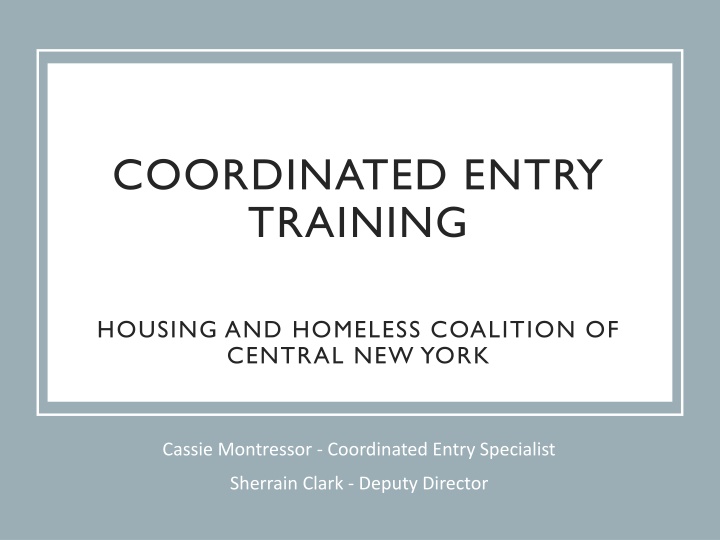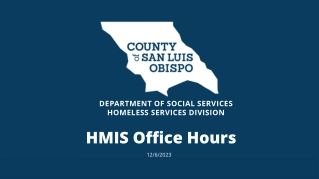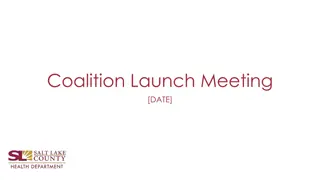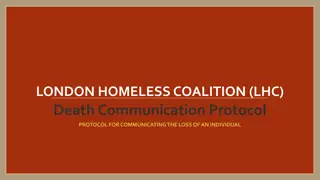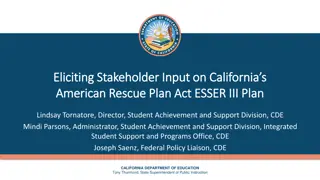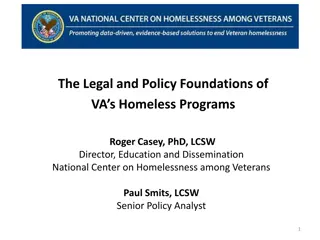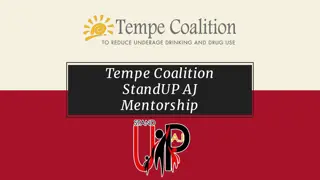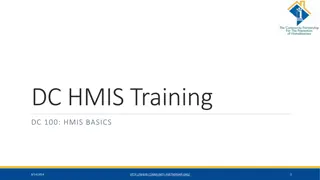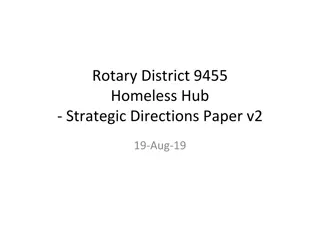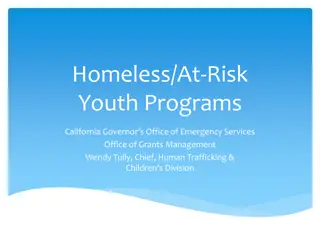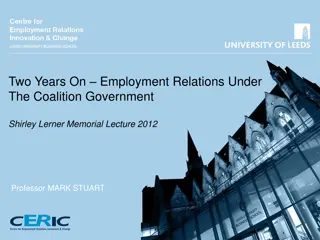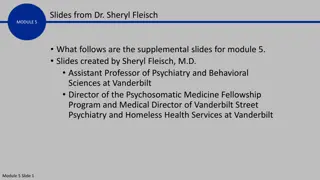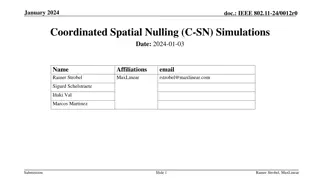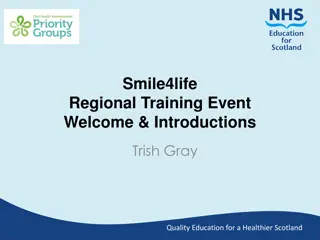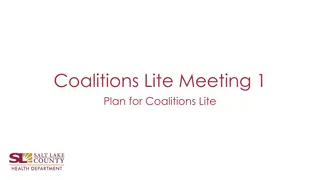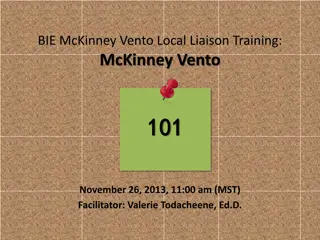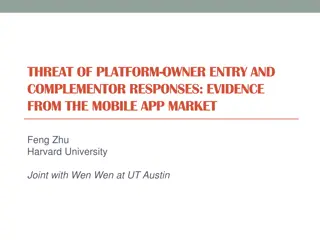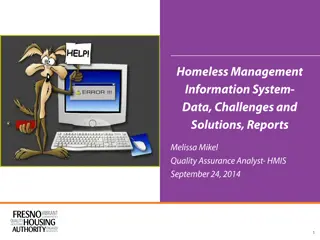Coordinated Entry Training and Homeless Coalition
Coordinated Entry Training by Housing and Homeless Coalition of Central New York covers key terms, progressive engagement, housing first, literal homelessness definitions, types, and philosophies. The agenda includes assessing chronic homelessness, client preferences, project types, prioritization, HMIS data entry, and more.
Download Presentation

Please find below an Image/Link to download the presentation.
The content on the website is provided AS IS for your information and personal use only. It may not be sold, licensed, or shared on other websites without obtaining consent from the author.If you encounter any issues during the download, it is possible that the publisher has removed the file from their server.
You are allowed to download the files provided on this website for personal or commercial use, subject to the condition that they are used lawfully. All files are the property of their respective owners.
The content on the website is provided AS IS for your information and personal use only. It may not be sold, licensed, or shared on other websites without obtaining consent from the author.
E N D
Presentation Transcript
COORDINATED ENTRY TRAINING HOUSING AND HOMELESS COALITION OF CENTRAL NEW YORK Cassie Montressor - Coordinated Entry Specialist Sherrain Clark - Deputy Director
Introductions Key Terms Progressive Engagement and Housing First Overview of Coordinated Entry System Assessment CNY-VI AGENDA Assessing Chronic Homelessness Client Preference Project Types ------- BREAK ------- Prioritization The CE List Entering Assessments in HMIS Recording Contacts in HMIS
WHAT IS COORDINATED ENTRY? Coordinated Entry describes how our community: Assesses Prioritizes and Refers People experiencing homelessness to HUD CoC Housing assistance resources.
LITERALLY HOMELESS Definition provided by HUD Individual or family who lacks a fixed, regular, and adequate nighttime residence CoC projects (PSH, TH, RRH, and ESG RRH) are for these households Does not include couch-surfing Source: https://www.hudexchange.info/resources/documents/Homel essDefinition_RecordkeepingRequirementsandCriteria.pdf
TYPES OF LITERAL HOMELESSNESS 1. Has a primary nighttime residence that is a public or private place not meant for human habitation; 2. Is living in a publicly or privately operated shelter designated to provide temporary living arrangements (including congregate shelters, transitional housing, and hotels and motels paid for by charitable organizations or by federal, state, and local government programs); or 3. Is exiting an institution where (s)he has resided for 90 days or less and who resided in an emergency shelter or place not meant for human habitation immediately before entering that institution 4. Is fleeing or attempting to flee domestic violence, has no other residence, and lacks the resources to obtain other permanent housing
PROGRESSIVE ENGAGEMENT AND HOUSING FIRST
PHILOSOPHIES OF COORDINATED ENTRY Progressive Engagement Provide only as much assistance as necessary to re-house a person Once housed, provide additional services that support household s goal of remaining housed
PROGRESSIVE ENGAGEMENT AND THE BLACK HOLE OF HOMELESSNESS People with less time homeless may need less assistance to become stably housed
BLACK HOLE OF HOMELESSNESS People remain homeless longer -> lose social ties/connections Lost social ties -> more difficult to get out of homelessness Assistance can catapult people out of homelessness
The solution to homelessness is safe and affordable permanent housing for everyone Watch YouTube video on the next slide which will explain the 5 Principles of the Housing First Model HOUSING FIRST
WHY HOUSING FIRST? Evidence shows that there are no reliable predictors of success in Housing First programs. Housing First respects client choices and autonomy.
OVERVIEW OF COORDINATED ENTRY SYSTEM
COORDINATED ENTRY SYSTEM FOR COC HOUSING PROGRAMS REFERRAL SOURCE Domestic Violence Shelter Emergency Shelter Street Outreach HOUSING PROJECTS Rapid Re- housing Permanent Supportive Housing HUD RAP ESG Supplemental HHC STAFF Prioritized Coordinated Entry List assessments matching
SHELTER AND STREET OUTREACH Assess clients Refer to coordinated entry Explain different program types to clients Refer to programs that the client is eligible for and that they are interested in. Manage referrals Update information as it changes Remove clients who have self- resolved or otherwise are no longer interested in services ROLES OF EACH PART OF THE SYSTEM
WHEN TO MAKE A REFERRAL (SHELTERS AND STREET OUTREACH) Client s first time being homeless, and they have not been able to find housing within the first 2-4 weeks If they are chronically homeless If they have a disability that is limiting them in obtaining or maintaining housing (many times homeless)
ROLES OF EACH PART OF THE SYSTEM Housing and Homeless Coalition Staff Check the quality of referrals Match households to housing provider openings Organize referrals in order of priority and distribute the list to the coordinated entry group Check that all entries to CoC-funded housing providers are coming from coordinated entry Organize Coordinated Entry Workgroup Coordinated Entry Training
Housing Service Providers Communicate openings to CE in a timely manner Contact clients that have been matched to the program in order of priority ROLES OF EACH PART OF THE SYSTEM Give clients 2 weeks to attempt to make contact Record contact attempts in HMIS Close out CE program entries when clients have moved into housing units
HOW MATCHING WORKS: STEP 1 Step 1: Housing providers contact CE staff when they have program openings via E-mail
Step 2: HHC Staff match the next person on the appropriate list that HOW MATCHING WORKS STEP 2: Has had recent contact with emergency shelter or street outreach staff Has not recently been matched or exited from that program Fits the program s targeting criteria
Step 3: Matches are communicated through the weekly CE email list. HOW MATCHING WORKS STEP 3: Matched housing provider column on lists RRH Matches or PSH Matches tab on list Matches may not always appear in order
Step 4: Providers contact clients directly or shelter case managers to set up appointments HOW MATCHING WORKS STEP 4: Matches are taken off the list when clients are opened in an RRH, TH, or PSH program
Step 5: Matches are removed when: HOW MATCHING WORKS STEP 5: Providers no longer have openings Clients have completed intake Clients have been contacted and choose not to participate in services Providers deny clients
Issues/Grievances/Inappropriate Matches HAVE QUESTIONS OR CONCERNS WITH YOUR MATCHES? Contact CE staff Cassandra Montressor, or Sherrain Clark Document reasons match is inappropriate in HMIS
WHAT IS THE PURPOSE OF CE ASSESSMENT? 1 2 3 Triage to determine household vulnerability and identify areas where supports are needed Target clients to achieve community goals (e.g. ending youth, family, and chronic homelessness) Aid in prioritizing program referral
The tool DOESNT make decisions about housing project referrals It DOESN T provide a diagnosis WHAT THE VULNERABILITY INDEX DOESN T DO: It DOESN T take the place of professional clinical assessment
Everyones very focused on - lets predict who can tmake it , but in fact, we can t predict who can make it. We really don t know. THE ASSESSMENT SCORE IS NOT A PREDICTION OF SUCCESS So, we have to give every single person a chance to demonstrate what they can do in that new environment. - Dr. Sam Tsemberis, creator of the first Housing First program in the US
3 COMPONENTS OF ASSESSMENT The CNY-VI Verifying History of Homelessness Client Preferences
Standardized Interview Based on client self- report Numerical rating of vulnerability Score is out of 25 CNY-VI CENTRAL NEW YORK- VULNERABILITY INDEX
Conduct the interview in a private room or confidential setting Store data securely. Paper copies should be locked in a cabinet. Files should only be saved in password-protected accounts or folders. CNY-VI MUSTS Maintain confidentiality Information about CNY-VI scores or what was learned through to course of the interview should only be shared while coordinating or providing services to the client.
RULES OF THUMB FOR ADMINISTERING THE CNY-VI Allow clients to stop or not answer when they choose The CNY-VI does not provide a suggestion for a housing project. Do not make housing referral decisions based on this score. Be attentive to power dynamics Workers who administer beds, food, etc. should not also conduct the CNY-VI if possible.
If a clients safety is in danger, talk to them about how or if they would like to proceed. Ask about what supports they would need in order to feel safer, and what strategies they could use to keep themselves safe. SAFETY Attempt to do a warm handoff to services like DV shelter, EMS, or other services.
Helps prioritize who gets served in housing services next WHAT DOES THE TOOL DO: Prompt conversations around barriers to housing
WHEN TO ENTER A NEW CNY-VI Enter a new CNY-VI if significant changes have occurred that would affect the client s vulnerability. Examples: substantially increased history of homelessness, new medical issues, loss of income, etc. If it appears that the client did not fully disclose all of the accurate information on the original survey.
ASSESSING CHRONIC HOMELESSNESS
CHRONIC HOMELESSNESS An individual who has a disabling condition AND Has been continuously homeless for a year or more OR Has had 4 or more episodes of homelessness in the last 3 years, adding up to 12 months. Source: https://www.hudexchange.info/resources/documents/DefiningChronicHomeless.pdf
DOCUMENTING TIME HOMELESS Episodes of homelessness must be separated by 7 days or more in a non-homeless housing situation (transitional housing, RRH, PSH, or living/ staying with friends or family). Documentation required for Chronic-dedicated Permanent Supportive Housing projects A small percentage of time can be self-reported.
ASSESSING CHRONIC HOMELESSNESS Step 1: Do your homework. Find all the client s shelter stays and count the number of months and episodes of homelessness in the last three years before meeting with the client, if possible. Step 2: Meet with your client and ask where they were during their gaps in shelter stays. Step 3: Document this information using the standardized PSH packet forms. Step 4: Collect disability documentation, self-certification, and third-party verification forms if necessary.
PSH ASSESSMENT PACKET Disability Documentation HHC Disability Verification form SSA Award Letter Other documentation signed by a health professional qualified to diagnose that disability in NYS Length of Time Documentation HMIS Entry/Exit Page Third-Party Verification Self-Certification
Your information goes here
Ensure at least one is checked Ensure at least one is checked Health Care Provider Information Here
THIRD-PARTY VERIFICATION OF HOMELESSNESS Third party means not the client or the PSH project. Should describe instances where the person was seen in a literally homeless situation at least once in each month verified.
Time Periods Requested by case manager Living situations verified by Third Party
Self-certification: When no third party can be reached to verify the client s living situation, the client can self-certify up to 3 months of their 12 months of homelessness. Breaks in homelessness: If a person is chronically homeless because they experienced homelessness 4+ times in the last three years, they must attest that they were housed at least 3 times in the last three years. SELF-CERTIFICATION / BREAKS
SELF- STATEMENT CERTIFICATION
BREAKS IN HOMELESSNESS CERTIFICATION
